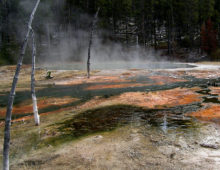Molecular Mechanisms of Parasitic Chytrids
Chytrids hinder algal biofuel cultivation by causing population crashes, but little is understood about how and under what conditions chytrids infect algae. Recently, researchers have found that the chytrid Paraphysoderma sedebokerense is a facultative algal parasite of Haematococcus pluvialis, whose trophic strategy is regulated by dissolved organic carbon availability. The molecular changes underlying its switch… [Read More]
